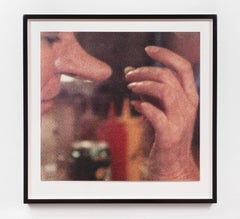John Baldessari Nose Prints
Recent Sales
2010s Contemporary Prints and Multiples
Digital
2010s Contemporary Figurative Prints
Screen
21st Century and Contemporary Pop Art Portrait Prints
Archival Ink
1990s Conceptual More Art
1970s Realist Portrait Prints
Lithograph
John Baldessari for sale on 1stDibs
Although Conceptual artist John Baldessari is best known for the richly provocative juxtapositions of photographic images and text that characterize his prints and paintings, he actually had something of a traditional art world upbringing — if such a thing exists.
Born in Southern California, Baldessari earned several art degrees, from art education to art history to painting. He also taught art at various institutions such as the California Institute of the Arts throughout his life. Among his many students were David Salle, Tony Oursler, Jim Shaw and Mike Kelley. While helping to shape the art world in Los Angeles, he simultaneously developed his own name as an artist.
In the 1950s, Baldessari’s works were primarily semiabstract paintings, but during the late 1960s, he began to distance himself from painting, as he bristled at the idea of limiting art to a single medium. Baldessari decided to take his career in a dramatically different direction. He burned all his paintings at a funeral home in San Diego, then incorporated the ashes into cookie dough, producing (nonedible) baked goods for an exhibition at the Museum of Modern Art in New York City.
“It was a very public and symbolic act,” he said, “like announcing you’re going on a diet in order to stick to it.”
From that point on, Baldessari took on an MO of experimentation, dabbling in mediums from video to printmaking to sculpture. “I just stare at something and say: Why isn’t that art? Why couldn’t that be art?” he said in an interview in 2008.
The works for which Baldessari is most highly regarded, however, are striking collages of images and text — many of which are seemingly nonsensical — such as Tom’s Hand Grips the Steering, Wheel… (2015), in which the title’s text is displayed beneath a hippopotamus. As such is his body of work: bringing a sense of joviality to the sometimes too-serious world of Conceptual art.
Before he died in 2020, Baldessari was honored with the 2014 National Medal of Arts Award, the Americans for the Arts Lifetime Achievement Award, the Venice Biennale’s Golden Lion for Lifetime Achievement and more.
Find original John Baldessari art on 1stDibs.
Finding the Right prints-works-on-paper for You
Decorating with fine art prints — whether they’re figurative prints, abstract prints or another variety — has always been a practical way of bringing a space to life as well as bringing works by an artist you love into your home.
Pursued in the 1960s and ’70s, largely by Pop artists drawn to its associations with mass production, advertising, packaging and seriality, as well as those challenging the primacy of the Abstract Expressionist brushstroke, printmaking was embraced in the 1980s by painters and conceptual artists ranging from David Salle and Elizabeth Murray to Adrian Piper and Sherrie Levine.
Printmaking is the transfer of an image from one surface to another. An artist takes a material like stone, metal, wood or wax, carves, incises, draws or otherwise marks it with an image, inks or paints it and then transfers the image to a piece of paper or other material.
Fine art prints are frequently confused with their more commercial counterparts. After all, our closest connection to the printed image is through mass-produced newspapers, magazines and books, and many people don’t realize that even though prints are editions, they start with an original image created by an artist with the intent of reproducing it in a small batch. Fine art prints are created in strictly limited editions — 20 or 30 or maybe 50 — and are always based on an image created specifically to be made into an edition.
Many people think of revered Dutch artist Rembrandt as a painter but may not know that he was a printmaker as well. His prints have been preserved in time along with the work of other celebrated printmakers such as Pablo Picasso, Salvador Dalí and Andy Warhol. These fine art prints are still highly sought after by collectors.
“It’s another tool in the artist’s toolbox, just like painting or sculpture or anything else that an artist uses in the service of mark making or expressing him- or herself,” says International Fine Print Dealers Association (IFPDA) vice president Betsy Senior, of New York’s Betsy Senior Fine Art, Inc.
Because artist’s editions tend to be more affordable and available than his or her unique works, they’re more accessible and can be a great opportunity to bring a variety of colors, textures and shapes into a space.
For tight corners, select small fine art prints as opposed to the oversized bold piece you’ll hang as a focal point in the dining area. But be careful not to choose something that is too big for your space. And feel free to lean into it if need be — not every work needs picture-hanging hooks. Leaning a larger fine art print against the wall behind a bookcase can add a stylish installation-type dynamic to your living room. (Read more about how to arrange wall art here.)
Find fine art prints for sale on 1stDibs today.

